川剧变脸英文版
川剧英文介绍
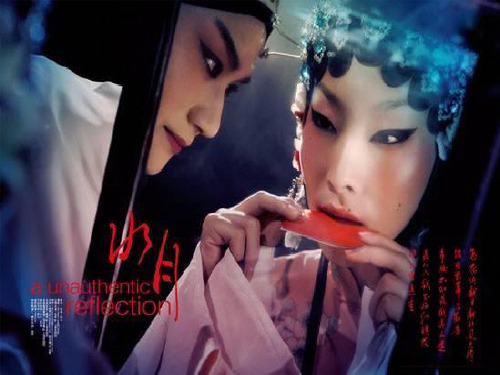
• Face-changing approachs can be divided into three ways:towel the face , blow the face and pull the face, in addition, there is a "luck face". • 川剧变脸可分为三种:抹脸、吹脸 和扯脸, 此外,还有一种“运气”变脸。
Thread is tied to clothes somewhere easily to work but not striking. During the performance , actors rip the masks off one by one under the cover of the dance movements. 丝线则系在衣服的某一个顺 手而又不引人注目的地方, 随着表演的需要,在舞蹈动 作的掩护下,再一张一张地 扯下来。
变脸是一种“瞬间艺术”,演 员根据剧情的需要,在极短的 时间内,在一抬手一拂袖一甩 头之间,变换出不同的面目 来——技艺纯熟者,往往只用 十几、廿秒钟就可幻化出十来 张不同的脸谱。
英语作文川剧变脸

英语作文川剧变脸The Intriguing Art of Sichuan Opera Face-ChangingThe Sichuan Opera, a captivating performance art that has enchanted audiences for centuries, is renowned for its mesmerizing technique of "face-changing," a breathtaking display of dexterity and showmanship. This ancient art form, deeply rooted in the cultural heritage of Sichuan, China, has captivated the hearts and minds of people around the world, leaving them in awe of the sheer skill and artistry involved.At the heart of the Sichuan Opera lies the captivating practice of face-changing, known as "Bian Lian" in Chinese. This unique technique involves the rapid and seamless transformation of a performer's facial mask, often within a matter of seconds, revealing a new and striking expression. The performers, known as "Bian Lian Masters," have honed their skills through years of intense training, perfecting the intricate movements and the precise timing required to execute these mesmerizing transformations.The art of face-changing is not merely a visual spectacle; it is a deeply symbolic and culturally significant tradition. Each mask,meticulously crafted, represents a distinct character or emotion, ranging from the fierce and intimidating to the whimsical and playful. The performers, through their effortless transitions, bring these characters to life, transporting the audience into a world of myth, legend, and high drama.The origins of face-changing can be traced back to the Ming Dynasty, where it was first introduced as a means of enhancing the theatrical experience of the Sichuan Opera. Over time, the technique has evolved, with each generation of performers adding their own unique twists and innovations to the art form. Today, the face-changing tradition is not only a source of cultural pride for the people of Sichuan but also a testament to the enduring spirit of artistic expression.The process of face-changing is a closely guarded secret, passed down from master to apprentice through rigorous training and meticulous attention to detail. The performers must possess an exceptional level of dexterity, coordination, and split-second timing to execute the rapid mask changes seamlessly. They often incorporate intricate hand movements, body contortions, and even acrobatic feats to enhance the overall theatrical experience.One of the most captivating aspects of face-changing is the element of surprise and unpredictability. The audience is kept on the edge oftheir seats, never quite sure when the next transformation will occur. The performers, with their lightning-fast reflexes and unwavering focus, are able to create a sense of awe and wonder, leaving the audience spellbound and eager to witness the next reveal.Beyond its technical prowess, the art of face-changing also holds deep cultural significance. The masks used in the Sichuan Opera are not merely props; they are imbued with symbolism and meaning. Each mask represents a specific character, emotion, or mythological figure, and the performer's ability to seamlessly transition between these personas is a testament to the rich tapestry of Chinese culture and storytelling.The preservation and promotion of the face-changing tradition have become a matter of great importance for the people of Sichuan and the broader Chinese cultural community. Efforts are being made to ensure that this art form is passed down to future generations, with dedicated schools and training programs established to nurture the next wave of Bian Lian Masters.In recent years, the global popularity of the Sichuan Opera and its face-changing technique has grown exponentially. Performances have been staged in major cities around the world, captivating audiences with their mesmerizing displays of skill and artistry. The universal appeal of this ancient art form lies in its ability to transcendcultural boundaries and speak to the human experience through the power of performance.In conclusion, the art of face-changing in the Sichuan Opera is a testament to the enduring spirit of human creativity and the power of cultural expression. Through the seamless transformation of masks and the embodiment of diverse characters, the Bian Lian Masters weave a tapestry of myth, legend, and emotion, leaving indelible impressions on all who witness their captivating performances. As this art form continues to evolve and captivate audiences worldwide, it stands as a shining example of the enduring richness and diversity of Chinese cultural heritage.。
英语作文川剧变脸

英语作文川剧变脸Sichuan Opera Face Changing, also known as "Bian Lian," is a mesmerizing traditional art form that originates from Sichuan Province in China. I had the opportunity to witness this incredible performance during a trip to Chengdu, and it left me spellbound.The highlight of the show was the rapid and seamless changing of masks by the performers. With a flick of the hand or a turn of the head, the performers would magically change their colorful masks in the blink of an eye. The swift and skillful movements, accompanied by dramatic music and lighting, created an electrifying atmosphere that kept the audience on the edge of their seats.The art of Sichuan Opera Face Changing requires years of practice and mastery. Each mask represents a different emotion or character, and the performers must switch between them effortlessly to convey the story effectively. It was truly a visual feast for the eyes and a cultural experience that I will never forget.中文翻译:四川变脸,又称“变脸”,是一种迷人的传统艺术形式,起源于中国四川省。
最新川剧变脸英文介绍
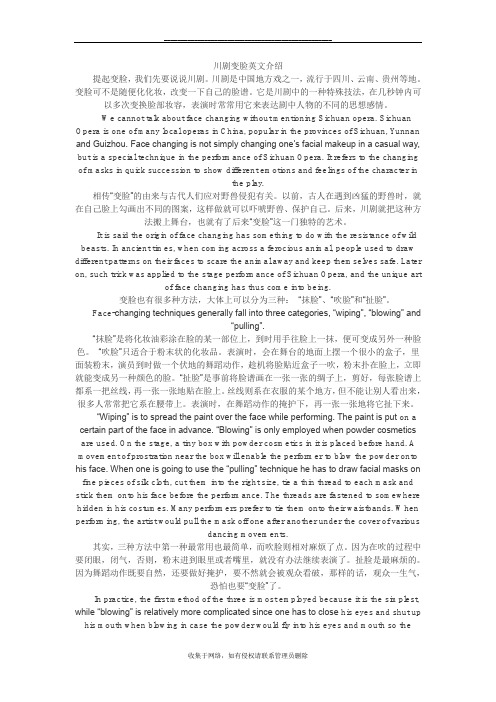
川剧变脸英文介绍提起变脸,我们先要说说川剧。
川剧是中国地方戏之一,流行于四川、云南、贵州等地。
变脸可不是随便化化妆,改变一下自己的脸谱。
它是川剧中的一种特殊技法,在几秒钟内可以多次变换脸部妆容,表演时常常用它来表达剧中人物的不同的思想感情。
We cannot talk about face changing without mentioning Sichuan opera. Sichuan Opera is one of many local operas in China, popular in the provinces of Sichuan, Yunnan and Guizhou. Face changing is not simply changing one’s facial makeup in a casual way, but is a special technique in the performance of Sichuan Opera. It refers to the changing of masks in quick succession to show different emotions and feelings of the character inthe play.相传“变脸”的由来与古代人们应对野兽侵犯有关。
以前,古人在遇到凶猛的野兽时,就在自己脸上勾画出不同的图案,这样做就可以吓唬野兽、保护自己。
后来,川剧就把这种方法搬上舞台,也就有了后来“变脸”这一门独特的艺术。
It is said the origin of face changing has something to do with the resistance of wild beasts. In ancient times, when coming across a ferocious animal, people used to draw different patterns on their faces to scare the animal away and keep themselves safe. Later on, such trick was applied to the stage performance of Sichuan Opera, and the unique artof face changing has thus come into being.变脸也有很多种方法,大体上可以分为三种:“抹脸”、“吹脸”和“扯脸”。
英文作文 四川变脸
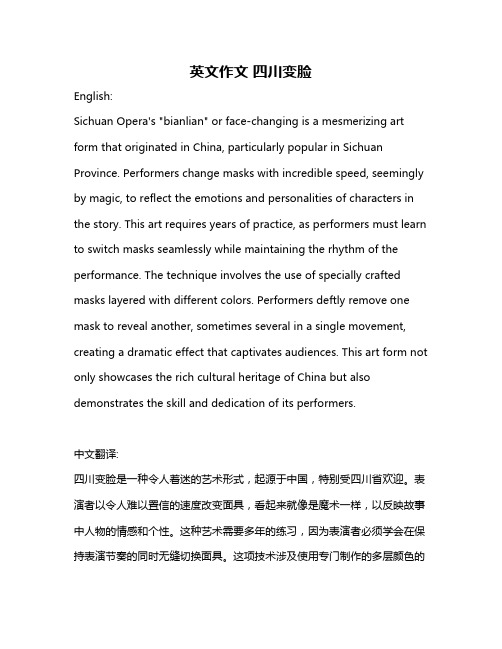
英文作文四川变脸English:Sichuan Opera's "bianlian" or face-changing is a mesmerizing art form that originated in China, particularly popular in Sichuan Province. Performers change masks with incredible speed, seemingly by magic, to reflect the emotions and personalities of characters in the story. This art requires years of practice, as performers must learn to switch masks seamlessly while maintaining the rhythm of the performance. The technique involves the use of specially crafted masks layered with different colors. Performers deftly remove one mask to reveal another, sometimes several in a single movement, creating a dramatic effect that captivates audiences. This art form not only showcases the rich cultural heritage of China but also demonstrates the skill and dedication of its performers.中文翻译:四川变脸是一种令人着迷的艺术形式,起源于中国,特别受四川省欢迎。
2024届高考英语语法填空:中国传统文化专题15成都文化课件
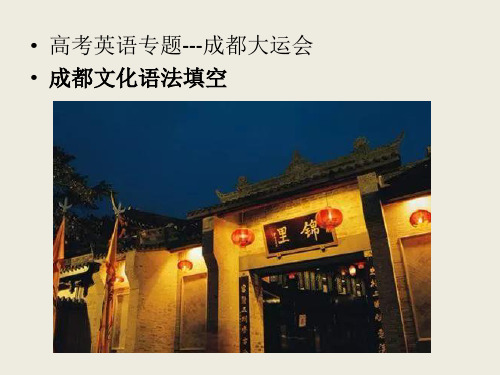
• Mascot: A panda called Rongbao with a torch in his hand ,who is in a running posture,will serve as the mascot for the 2021 Summer Universiade in Chengdu. The flame above the torch is in the shape of “31”, representing the 31st edition of the Universiade, and Rongbao’s ears, eyes and tail are all in the shape of flame. The panda’s facial features also resemble the style of make-up used in Sichuan’s traditional opera.
• 【吉祥物】
• A panda called Rongbao with a torch in his hand, who is in a running posture, will serve as the mascot for the 2021 Summer Universiade in Chengdu. The flame above the torch is in the shape of “31”, representing the 31st edition of the Universiade, and Rongbao’s ears, eyes and tail are all in the shape of flame. The panda’s facial features also resemble the style of make-up used in Sichuan’s traditional opera.
神奇的川剧变脸作文英语
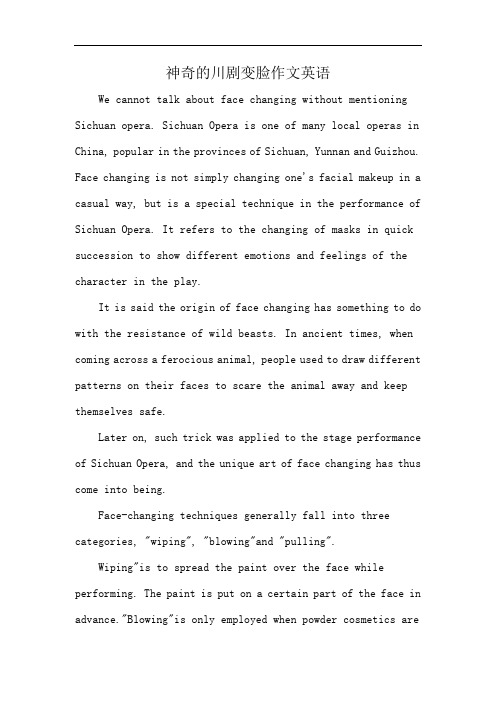
神奇的川剧变脸作文英语We cannot talk about face changing without mentioning Sichuan opera. Sichuan Opera is one of many local operas in China, popular in the provinces of Sichuan, Yunnan and Guizhou. Face changing is not simply changing one's facial makeup in a casual way, but is a special technique in the performance of Sichuan Opera. It refers to the changing of masks in quick succession to show different emotions and feelings of the character in the play.It is said the origin of face changing has something to do with the resistance of wild beasts. In ancient times, when coming across a ferocious animal, people used to draw different patterns on their faces to scare the animal away and keep themselves safe.Later on, such trick was applied to the stage performance of Sichuan Opera, and the unique art of face changing has thus come into being.Face-changing techniques generally fall into three categories, "wiping", "blowing"and "pulling".Wiping"is to spread the paint over the face while performing. The paint is put on a certain part of the face in advance."Blowing"is only employed when powder cosmetics areused. On the stage,a tiny box with powder cosmetics in it is placed before hand.A movement of prostration near the box will enable the performer to blow the powder onto his face. When one is going to use the "pulling"technique he has to draw facial masks on fine pieces of silk cloth, cut them into the right size, tie a thin thread to each mask and stick them onto his face before the performance. The threads are fastened to somewhere hidden in his costumes. Many performers prefer to tie them onto their waistbands. When performing, the artist would pull the mask off one after another under the cover of various dancing movements.In practice,the first method of the three is most employed because it is the simplest, while"blowing"is relatively more complicated since one has to close his eyes and shut up his mouth when blowing in case the powder would fly into his eyes and mouth so the performance would not be continued. However,"pulling"is the most troublesome among the three skills. The dancing movements have to be natural and the action of pulling should be invisible to the audience. If the audience sees through the trick of face changing, they would probably get dissatisfied and pull a face too!。
邀请老师来顾客川剧变脸的英语作文
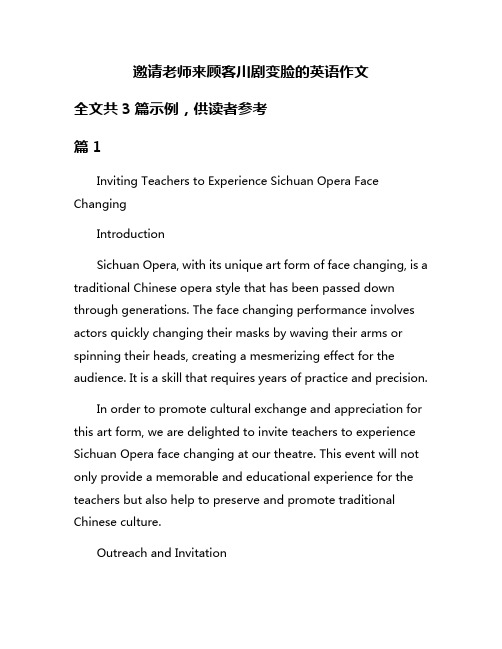
邀请老师来顾客川剧变脸的英语作文全文共3篇示例,供读者参考篇1Inviting Teachers to Experience Sichuan Opera Face ChangingIntroductionSichuan Opera, with its unique art form of face changing, is a traditional Chinese opera style that has been passed down through generations. The face changing performance involves actors quickly changing their masks by waving their arms or spinning their heads, creating a mesmerizing effect for the audience. It is a skill that requires years of practice and precision.In order to promote cultural exchange and appreciation for this art form, we are delighted to invite teachers to experience Sichuan Opera face changing at our theatre. This event will not only provide a memorable and educational experience for the teachers but also help to preserve and promote traditional Chinese culture.Outreach and InvitationWe extend a warm invitation to all teachers to join us for a special evening of Sichuan Opera face changing. The event will take place at our theatre on [date] at [time]. Teachers from all subjects and disciplines are welcome to attend this unique cultural experience.To RSVP, please contact [name] at [email address] or [phone number]. We kindly request that all teachers confirm their attendance by [deadline] to ensure we can accommodate everyone.Event DetailsThe evening will begin with a brief introduction to Sichuan Opera and the history of face changing. Our knowledgeable guides will provide insights into the techniques and traditions behind this art form. Following the introduction, teachers will have the opportunity to witness a live demonstration of face changing by our seasoned performers.During the performance, teachers will be able to observe the intricate movements and gestures that the actors use to switch masks seamlessly. They will also have the chance to ask questions and interact with the performers to gain a deeper understanding of Sichuan Opera and its significance in Chinese culture.In addition to the face changing demonstration, teachers will enjoy a traditional Sichuan Opera performance featuring colorful costumes, elaborate makeup, and dazzling acrobatics. This immersive experience will transport them to a world of ancient legends and folklore, providing a rich tapestry of sights and sounds.Benefits of ParticipationParticipating in this event will offer teachers a unique opportunity to broaden their cultural horizons and gain a deeper appreciation for traditional Chinese arts. By witnessing the skill and precision required for face changing, teachers can gain new insights into the dedication and craftsmanship of performers in preserving this ancient art form.Moreover, experiencing Sichuan Opera face changing firsthand can inspire creativity and innovation in the classroom. Teachers may discover new ways to engage and captivate their students through the use of visual storytelling and theatrical techniques.ConclusionWe hope that teachers will seize this opportunity to immerse themselves in the world of Sichuan Opera face changing andgain a deeper appreciation for Chinese culture. By participating in this event, educators can foster cross-cultural understanding and inspire a sense of curiosity and wonder in their students.We look forward to welcoming teachers to our theatre for a memorable evening of Sichuan Opera face changing. Together, we can celebrate the beauty and artistry of this ancient tradition and inspire a new generation to cherish and preserve our cultural heritage.篇2Inviting Teachers to Experience Sichuan OperaFace-ChangingIntroductionSichuan Opera Face-Changing, also known as "Bian Lian" in Chinese, is a traditional Chinese dramatic art that originated in Sichuan Province. It is characterized by performers changing masks instantaneously during their performances, creating a mesmerizing and magical effect for the audience. The skill of Face-Changing has been passed down for generations and has become an integral part of Chinese cultural heritage. In order to promote this unique art form and provide a cultural experience for our teachers, we have organized a special event to invitethem to witness a live Sichuan Opera Face-Changing performance.InvitationDear Teachers,We are excited to invite you to participate in a special event where you will have the opportunity to experience the captivating art of Sichuan Opera Face-Changing. This event will take place on [date] at [time] in the school auditorium. We believe that this unique cultural experience will not only entertain and delight you but also provide you with a deeper understanding of traditional Chinese art and culture.Event DetailsDuring the event, you will have the chance to witness a live demonstration of Sichuan Opera Face-Changing by a seasoned performer who has mastered this art form. You will be amazed by the quick and skillful mask changes that will take place right before your eyes. Through this performance, you will gain insight into the rich history and traditions of Sichuan Opera and appreciate the artistry and craftsmanship involved inFace-Changing.BenefitsBy attending this event, you will not only have a memorable and enjoyable experience but also enrich your cultural knowledge and appreciation. Sichuan Opera Face-Changing is a rare and unique art form that is not commonly seen outside of China, so this event presents a special opportunity for you to witness something truly extraordinary. We believe that by experiencing this traditional art form, you will gain a greater appreciation for Chinese culture and heritage.ConclusionWe hope that you will join us for this exciting event and take part in this immersive cultural experience. Sichuan OperaFace-Changing is a truly fascinating and enchanting art form that is sure to leave a lasting impression on all who witness it. We look forward to sharing this special event with you and hope that it will inspire a deeper appreciation for traditional Chinese arts and culture.Sincerely,[Your Name]This invitation is a wonderful opportunity for our teachers to experience the magic of Sichuan Opera Face-Changing and gain a deeper understanding of Chinese culture. We believe that thisevent will be both educational and entertaining, providing our teachers with a unique cultural experience that they will remember for years to come.篇3Inviting teachers to watch Sichuan Opera "Bian Lian" performanceIntroductionSichuan Opera, also known as Chuanju, is a famous traditional Chinese opera that originated in Sichuan province. One of the most unique and popular acts in Sichuan Opera is Bian Lian, also known as "Face Changing." This act involves performers changing their face masks in the blink of an eye, creating a mesmerizing and magical effect. It requires a high level of skill and technique, as well as years of practice to perfect. In order to appreciate the beauty and skill of this traditional art form, our school has decided to invite teachers to watch a special "Bian Lian" performance.PurposeThe purpose of this event is to introduce teachers to the rich cultural heritage of Sichuan Opera and cultivate an appreciation for traditional Chinese performing arts. By watching the "BianLian" performance, teachers will not only be entertained but will also gain a deeper understanding of the history and techniques behind this unique art form.Event DetailsDate: [Insert Date]Time: [Insert Time]Venue: [Insert Venue]Duration: Approximately 1 hourSchedule:- Opening remarks- Introduction to Sichuan Opera and "Bian Lian"- "Bian Lian" performance- Q&A session with performers- Closing remarksBenefitsBy attending this event, teachers will have the opportunity to:- Explore and appreciate traditional Chinese performing arts- Gain insights into the history and techniques of Sichuan Opera- Learn about the cultural significance of "Bian Lian"- Support local artists and cultural preservation efforts- Enjoy a unique and entertaining performanceConclusionWe hope that by inviting teachers to watch the Sichuan Opera "Bian Lian" performance, they will gain a renewed appreciation for traditional Chinese arts and culture. This event not only serves as a form of entertainment but also as an educational opportunity to learn about the rich heritage of Sichuan Opera. We look forward to seeing you at the event and sharing this cultural experience together. Thank you for your support and participation.。
英语作文川剧变脸
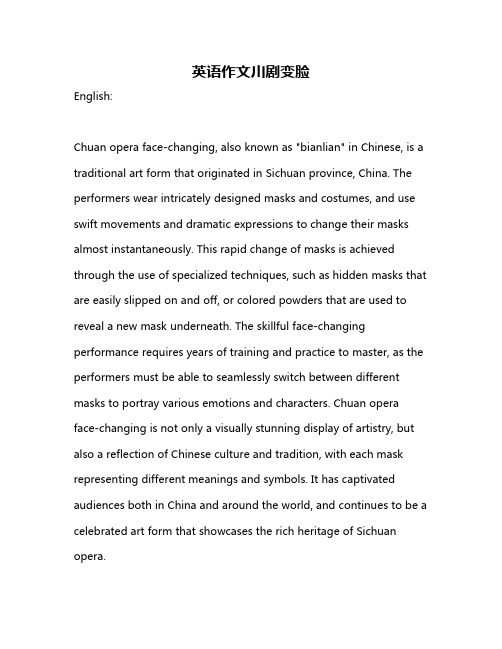
英语作文川剧变脸English:Chuan opera face-changing, also known as "bianlian" in Chinese, is a traditional art form that originated in Sichuan province, China. The performers wear intricately designed masks and costumes, and use swift movements and dramatic expressions to change their masks almost instantaneously. This rapid change of masks is achieved through the use of specialized techniques, such as hidden masks that are easily slipped on and off, or colored powders that are used to reveal a new mask underneath. The skillful face-changing performance requires years of training and practice to master, as the performers must be able to seamlessly switch between different masks to portray various emotions and characters. Chuan opera face-changing is not only a visually stunning display of artistry, but also a reflection of Chinese culture and tradition, with each mask representing different meanings and symbols. It has captivated audiences both in China and around the world, and continues to be a celebrated art form that showcases the rich heritage of Sichuan opera.中文翻译:川剧变脸,又称为“变脸”在中国,是一种源自中国四川省的传统艺术形式。
高中英语书面表达中国传统文化川剧话题Sichuan Opera
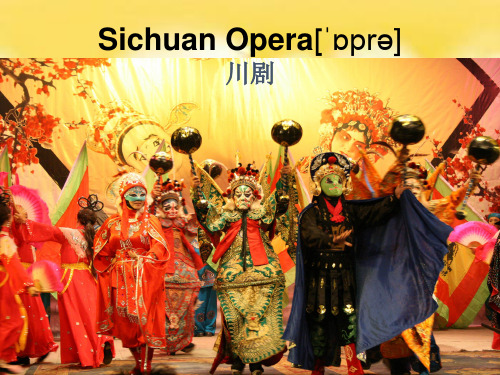
川剧
Face -changing is a "moment of art", according to the needs of the story, actors change the different masks in a very short time of raising hands or tossing sleeve during the perform. And the skilled person often change dozen of masks in only ten or twenty seconds.
• Face-changing approachs can be divided into three ways:towel the face , blow the face and pull the face, in addition, there is a "luck face".
• 川剧变脸可分为三种:抹脸、吹脸 和扯脸,此 外,还有一种“运气”变脸。
变脸是一种“瞬间艺术”,演 员根据剧情的需要,在极短 的时间内,在一抬手一拂袖 一甩头之间,变换出不同的 面目来——技艺纯熟者,往 往只用十几、二十秒钟就可 幻化出十来张不同的脸谱。
And different masks can show the emotions of characters and sudden changes of mental state, such as fear, despair, anger, etc.
而不同的脸谱用以表现剧 中人物的情绪和心理状态 的突然变化,如惊恐、绝 望、愤怒、等等。
• 颜色特征 红色 表现性情激烈、忠耿正大的人物 关羽 黄色 表现体格不健壮、实则勇武过人的角色 甘宁 蓝色(绿) 表现凶猛、恐怖的人物 卢杞、恶鬼 白色 表现奸诈、阴险的人物 曹操、董卓 黑色 表现正直、坦率、鲁莽的人物 张飞、李逵
介绍川剧变脸的英语作文
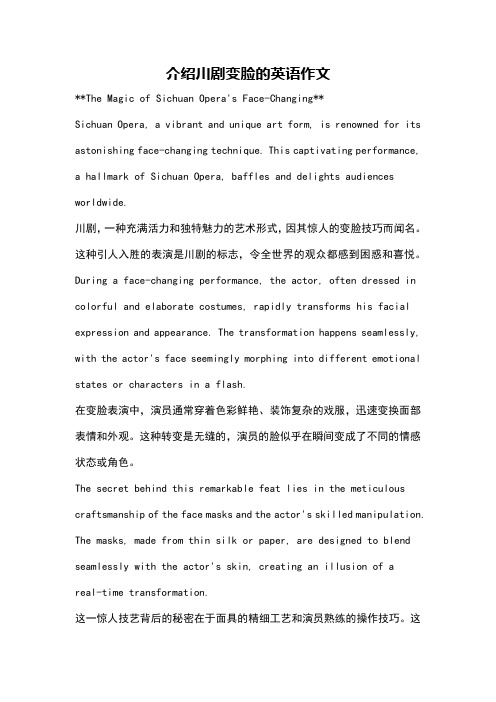
介绍川剧变脸的英语作文**The Magic of Sichuan Opera's Face-Changing**Sichuan Opera, a vibrant and unique art form, is renowned for its astonishing face-changing technique. This captivating performance, a hallmark of Sichuan Opera, baffles and delights audiences worldwide.川剧,一种充满活力和独特魅力的艺术形式,因其惊人的变脸技巧而闻名。
这种引人入胜的表演是川剧的标志,令全世界的观众都感到困惑和喜悦。
During a face-changing performance, the actor, often dressed in colorful and elaborate costumes, rapidly transforms his facial expression and appearance. The transformation happens seamlessly, with the actor's face seemingly morphing into different emotional states or characters in a flash.在变脸表演中,演员通常穿着色彩鲜艳、装饰复杂的戏服,迅速变换面部表情和外观。
这种转变是无缝的,演员的脸似乎在瞬间变成了不同的情感状态或角色。
The secret behind this remarkable feat lies in the meticulous craftsmanship of the face masks and the actor's skilled manipulation. The masks, made from thin silk or paper, are designed to blend seamlessly with the actor's skin, creating an illusion of areal-time transformation.这一惊人技艺背后的秘密在于面具的精细工艺和演员熟练的操作技巧。
关于介绍川剧变脸的英语作文
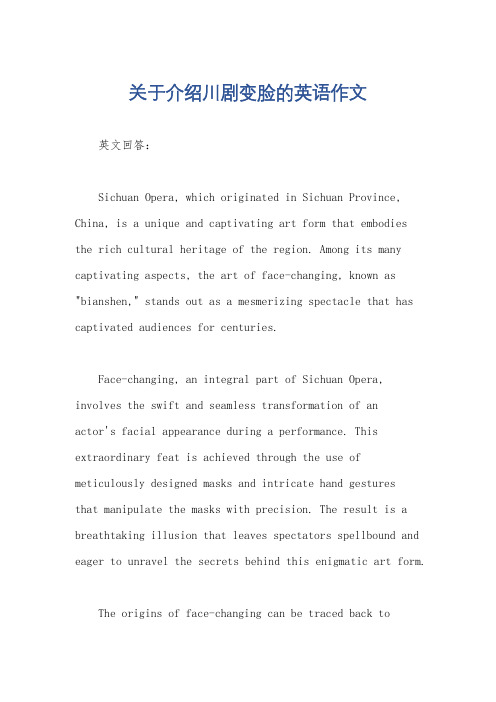
关于介绍川剧变脸的英语作文英文回答:Sichuan Opera, which originated in Sichuan Province, China, is a unique and captivating art form that embodiesthe rich cultural heritage of the region. Among its many captivating aspects, the art of face-changing, known as "bianshen," stands out as a mesmerizing spectacle that has captivated audiences for centuries.Face-changing, an integral part of Sichuan Opera, involves the swift and seamless transformation of anactor's facial appearance during a performance. This extraordinary feat is achieved through the use of meticulously designed masks and intricate hand gesturesthat manipulate the masks with precision. The result is a breathtaking illusion that leaves spectators spellbound and eager to unravel the secrets behind this enigmatic art form.The origins of face-changing can be traced back toancient Chinese rituals and performances. In these early ceremonies, masks were employed to represent variousdeities and spirits, embodying their powers and characteristics. Over time, the use of masks evolved into a theatrical art form, and face-changing became an integral part of Sichuan Opera.The masks used in face-changing are crafted from a variety of materials, including paper, silk, and leather. Each mask is meticulously designed to portray a specific character, emotion, or expression. The masks are often adorned with elaborate designs, vibrant colors, andintricate patterns that enhance their visual impact.The techniques employed in face-changing are as impressive as the masks themselves. Actors undergo rigorous training to master the art of manipulating the masks with lightning speed and precision. They utilize a combination of hand gestures, body movements, and facial contortions to seamlessly switch between different masks, creating an illusion of effortless transformation.The process of face-changing is shrouded in secrecy, as each troupe closely guards its unique techniques. However, some general principles have been revealed over time. One common method involves attaching the masks to a thin wire or string, which is then manipulated by the actor's hand or mouth to change the mask in a split second.Another technique involves using a mask holder concealed within the actor's costume. This allows the actor to quickly switch between masks by sliding them in and out of the holder, creating a smooth and seamless transition.The impact of face-changing on the audience is undeniable. The ability to transform facial appearances in an instant creates a sense of awe and wonder, captivating spectators and transporting them into a world of imagination and fantasy. Face-changing has become a signature element of Sichuan Opera, attracting audiences from around the world who marvel at the skill and artistry of its performers.In addition to its entertainment value, face-changingalso holds cultural significance. It represents the rich tradition of Chinese storytelling and showcases the innovation and creativity of Sichuan Opera artists. The art form continues to evolve and fascinate audiences, ensuring its place as a cherished part of China's cultural heritage.中文回答:川剧变脸介绍。
川剧变脸表演英语作文

川剧变脸表演英语作文Title: The Art of Face-Changing in Sichuan Opera。
Sichuan Opera, a traditional Chinese opera that originates from the southwestern province of Sichuan, is renowned for its unique and captivating art form known as "face-changing." This dramatic and visually stunning technique, also known as "Bian Lian," involves performers swiftly changing their masks or face paints in full view of the audience, creating a mesmerizing spectacle that combines art, culture, and magic.The history of Sichuan Opera dates back over 400 years, during the Qing Dynasty, evolving from local folk performances and influences from other Chinese opera forms. Over time, it integrated various elements such as singing, dancing, martial arts, and acrobatics, but the most distinctive feature that sets it apart is undoubtedly the art of face-changing.Face-changing started as a way to express the inner feelings and thoughts of characters without words. It issaid that the technique was originally used to reflect sudden changes in a character’s emotion, from anger to joy, or fear to excitement. This technique allows the performerto convey a rich range of emotions, contributing to the dramatic tension and enhancing the storytelling aspect of the opera.Performers of face-changing wear brightly colored costumes and elaborately designed masks. The masks are crafted with materials that can adhere closely to the skin but can also be removed swiftly and seamlessly. The techniques of changing masks are closely guarded secrets, traditionally passed down from one generation to the next within families. Although some aspects involve mechanical devices, many changes are done manually by the performers using methods such as pulling an attached thread or subtly blowing off a mask.A typical performance involves several characters, each demonstrating various emotions and symbolisms through theirmasks. The colors of the masks are deeply symbolic; for example, red might represent bravery or loyalty, while black could signify boldness or neutrality. The suddenshift from one color to another, often in the blink of an eye, leaves audiences amazed and adds to the mystique of the performance.The skill of face-changing requires years of practice to master. Performers must have precise timing and deft movements, coupled with the ability to act and dance. They must also possess a strong presence of mind and body coordination, as the slightest mishap can disrupt the seamless flow of the performance.Today, face-changing is not only a highlight of Sichuan Opera but also a cultural emblem of China, fascinating audiences worldwide. It has been featured in various international cultural festivals and tours, where it often steals the show as a striking example of Chinese cultural heritage.For tourists visiting China, a Sichuan Operaperformance featuring face-changing is a must-see. The experience of watching these artists transform their identities so swiftly and artistically in vibrant, dramatic settings is both enchanting and unforgettable. Many opera houses in Chengdu, the capital city of Sichuan, offer regular performances, providing an accessible glimpse into this extraordinary art form.In conclusion, the art of face-changing in Sichuan Opera is a profound cultural treasure that embodies the creativity, history, and spirit of Chinese performing arts. It stands as a testament to the skill and dedication of its performers and continues to inspire and captivate audiences around the world with its dramatic flair and mystical transformations. As more people seek to understand and appreciate this unique cultural expression, face-changing remains not only a pivotal aspect of Sichuan Opera but also an enduring symbol of the rich tapestry of Chinese culture.。
川剧变脸表演英语作文
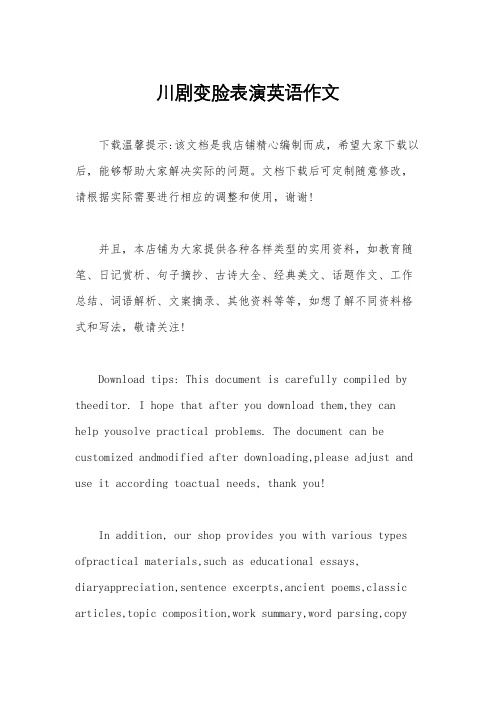
川剧变脸表演英语作文下载温馨提示:该文档是我店铺精心编制而成,希望大家下载以后,能够帮助大家解决实际的问题。
文档下载后可定制随意修改,请根据实际需要进行相应的调整和使用,谢谢!并且,本店铺为大家提供各种各样类型的实用资料,如教育随笔、日记赏析、句子摘抄、古诗大全、经典美文、话题作文、工作总结、词语解析、文案摘录、其他资料等等,如想了解不同资料格式和写法,敬请关注!Download tips: This document is carefully compiled by theeditor. I hope that after you download them,they can help yousolve practical problems. The document can be customized andmodified after downloading,please adjust and use it according toactual needs, thank you!In addition, our shop provides you with various types ofpractical materials,such as educational essays, diaryappreciation,sentence excerpts,ancient poems,classic articles,topic composition,work summary,word parsing,copyexcerpts,other materials and so on,want to know different data formats andwriting methods,please pay attention!ChatGPT:1. Colorful Facade of Art: The Wonders of Sichuan Face Change。
变脸英文介绍
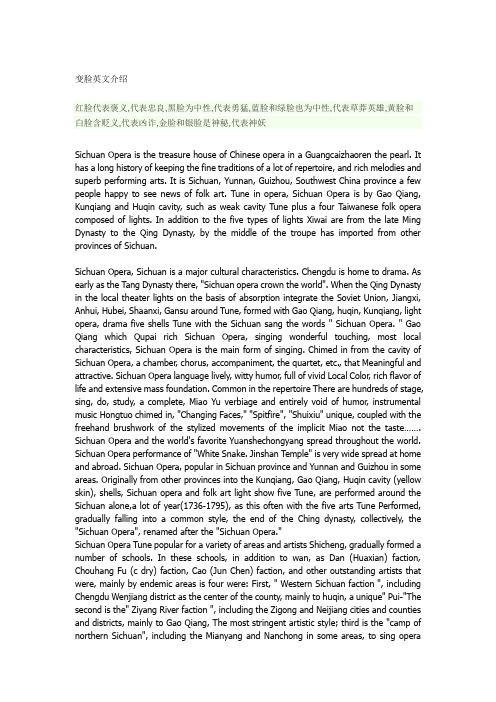
变脸英文介绍红脸代表褒义,代表忠良,黑脸为中性,代表勇猛,蓝脸和绿脸也为中性,代表草莽英雄,黄脸和白脸含贬义,代表凶诈,金脸和银脸是神秘,代表神妖Sichuan Opera is the treasure house of Chinese opera in a Guangcaizhaoren the pearl. It has a long history of keeping the fine traditions of a lot of repertoire, and rich melodies and superb performing arts. It is Sichuan, Yunnan, Guizhou, Southwest China province a few people happy to see news of folk art. Tune in opera, Sichuan Opera is by Gao Qiang, Kunqiang and Huqin cavity, such as weak cavity Tune plus a four Taiwanese folk opera composed of lights. In addition to the five types of lights Xiwai are from the late Ming Dynasty to the Qing Dynasty, by the middle of the troupe has imported from other provinces of Sichuan.Sichuan Opera, Sichuan is a major cultural characteristics. Chengdu is home to drama. As early as the Tang Dynasty there, "Sichuan opera crown the world". When the Qing Dynasty in the local theater lights on the basis of absorption integrate the Soviet Union, Jiangxi, Anhui, Hubei, Shaanxi, Gansu around Tune, formed with Gao Qiang, huqin, Kunqiang, light opera, drama five shells Tune with the Sichuan sang the words " Sichuan Opera. " Gao Qiang which Qupai rich Sichuan Opera, singing wonderful touching, most local characteristics, Sichuan Opera is the main form of singing. Chimed in from the cavity of Sichuan Opera, a chamber, chorus, accompaniment, the quartet, etc., that Meaningful and attractive. Sichuan Opera language lively, witty humor, full of vivid Local Color, rich flavor of life and extensive mass foundation. Common in the repertoire There are hundreds of stage, sing, do, study, a complete, Miao Yu verbiage and entirely void of humor, instrumental music Hongtuo chimed in, "Changing Faces,""Spitfire", "Shuixiu" unique, coupled with the freehand brus hwork of the stylized movements of the implicit Miao not the taste……. Sichuan Opera and the world's favorite Yuanshechongyang spread throughout the world. Sichuan Opera performance of "White Snake. Jinshan Temple" is very wide spread at home and abroad. Sichuan Opera, popular in Sichuan province and Yunnan and Guizhou in some areas. Originally from other provinces into the Kunqiang, Gao Qiang, Huqin cavity (yellow skin), shells, Sichuan opera and folk art light show five Tune, are performed around the Sichuan alone,a lot of year(1736-1795), as this often with the five arts Tune Performed, gradually falling into a common style, the end of the Ching dynasty, collectively, the "Sichuan Opera", renamed after the "Sichuan Opera."Sichuan Opera Tune popular for a variety of areas and artists Shicheng, gradually formed a number of schools. In these schools, in addition to wan, as Dan (Huaxian) faction, Chouhang Fu (c dry) faction, Cao (Jun Chen) faction, and other outstanding artists that were, mainly by endemic areas is four were: First, " Western Sichuan faction ", including Chengdu Wenjiang district as the center of the county, mainly to huqin, a unique" Pui-"The second is the" Ziyang River faction ", including the Zigong and Neijiang cities and counties and districts, mainly to Gao Qiang, The most stringent artistic style; third is the "camp of northern Sichuan", including the Mianyang and Nanchong in some areas, to sing operashells mainly affected by the Shaanxi Opera School; and fourth, "East Sichuan faction", including to Chongqing as the center along the East Sichuan , As a result of Sichuan, Chongqing Commercial Centre, to the performance of many foreign Operas. Road show is characterized by complex and diversified Tune.Sichuan Opera performances rich flavor of life, lively, witty humor, in order to better shape figures, Sichuan Opera artists to create a face, Cangdao, drilling Huoquan, open eye, and bianmany other skills, performing at the popular festive, fun new form of a Sichuan Opera Characteristics.Sichuan Opera is the face of the special skills of the performing arts one. It is the characters inner thoughts and feelings of the performance of a romantic way. Face approach can be divided into three types - hand face, blowing face,push face.Gao Qiang Sichuan Opera is the most important of a Tune, is imported from the late Ming and early Qing Dynasty in Sichuan. Gao Qiang after the introduction of Sichuan, with the Sichuan dialect, folk songs, labor, the son of the Inter-rap and other forms After processing and refining, and gradually formed a Tune with local characteristics of music.Sichuan Opera is Qupai of music Gao Qiang, Sichuan Opera Gao Qiang Qupai large number of complex forms. It is basically the structure can be summarized as: from the cavity, column, singing, Saowei. Gao Qiang repertoire, themes wide variety of text to word format. Gao Qiang is the most important features of the accompaniment of musical instruments do not sing the so-called "singing and the public," the only song form, to help a sing it as one. Qupai of gongs and drums are composed of in this way. Some Qupai chimed in more than singing, and some basic all chimed in, some Qupai only two have both chimed in, the concrete form of a decision by the show.Sichuan Opera-Xiaosheng, Danjiao, the Health Kok, Erhualian, Harlequin five representatives,Zichengtiji have the power of procedures, particularly Stevenson, clowning, the most Danjiao performance characteristics, drama performance in practice, performing techniques in more Outstanding creation, can fully reflect actual situation of Chinese Opera of Health, leaving the aesthetic characteristics shape freehand brushwork。
高中英语作文题目 川剧变脸
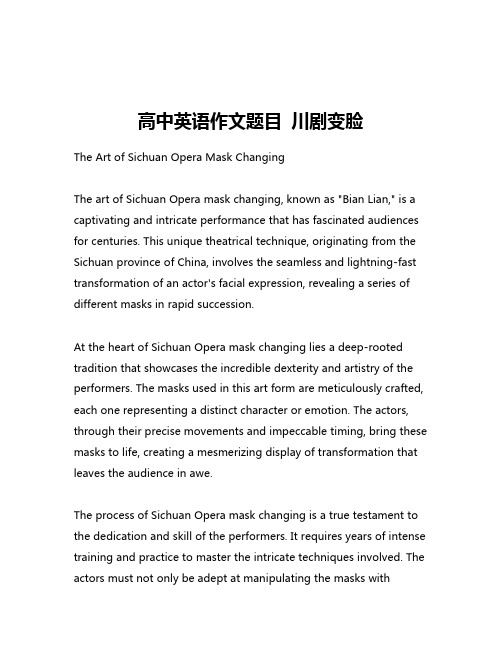
高中英语作文题目川剧变脸The Art of Sichuan Opera Mask ChangingThe art of Sichuan Opera mask changing, known as "Bian Lian," is a captivating and intricate performance that has fascinated audiences for centuries. This unique theatrical technique, originating from the Sichuan province of China, involves the seamless and lightning-fast transformation of an actor's facial expression, revealing a series of different masks in rapid succession.At the heart of Sichuan Opera mask changing lies a deep-rooted tradition that showcases the incredible dexterity and artistry of the performers. The masks used in this art form are meticulously crafted, each one representing a distinct character or emotion. The actors, through their precise movements and impeccable timing, bring these masks to life, creating a mesmerizing display of transformation that leaves the audience in awe.The process of Sichuan Opera mask changing is a true testament to the dedication and skill of the performers. It requires years of intense training and practice to master the intricate techniques involved. The actors must not only be adept at manipulating the masks withlightning-fast speed but also possess a deep understanding of the characters and the emotions they represent.One of the most captivating aspects of Sichuan Opera mask changing is the sheer speed and fluidity with which the transformations occur. The actors deftly remove and replace the masks, often in a matter of seconds, creating the illusion of a seamless flow of emotions and expressions. This feat of physical and mental dexterity is a true testament to the performers' years of rigorous training and dedication to their craft.Beyond the technical prowess, Sichuan Opera mask changing also holds deep cultural and symbolic significance. The masks used in this art form are not merely props; they are imbued with rich symbolism and represent the diverse range of characters and emotions that are central to the Sichuan Opera tradition. From the stern and authoritative to the whimsical and mischievous, each mask tells a story and evokes a specific emotional response from the audience.The art of Sichuan Opera mask changing is not only a visual spectacle but also a reflection of the deep-rooted cultural heritage of the Sichuan region. It is a performance that transcends the boundaries of mere entertainment, serving as a window into the rich tapestry of Chinese theatrical traditions.As the world continues to embrace and appreciate the cultural diversity of our planet, the art of Sichuan Opera mask changing stands as a shining example of the enduring power of artistic expression. It is a testament to the human capacity for creativity, innovation, and the preservation of timeless traditions. Through the mesmerizing performances of Sichuan Opera mask changers, audiences are transported to a realm of enchantment, where the boundaries between reality and illusion blur, and the true essence of the human experience is celebrated in all its captivating glory.。
川剧变脸的英文作文
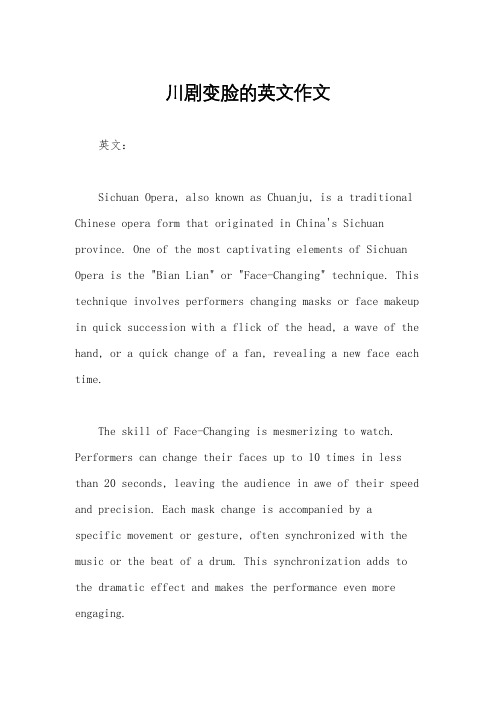
川剧变脸的英文作文英文:Sichuan Opera, also known as Chuanju, is a traditional Chinese opera form that originated in China's Sichuan province. One of the most captivating elements of Sichuan Opera is the "Bian Lian" or "Face-Changing" technique. This technique involves performers changing masks or face makeup in quick succession with a flick of the head, a wave of the hand, or a quick change of a fan, revealing a new face each time.The skill of Face-Changing is mesmerizing to watch. Performers can change their faces up to 10 times in less than 20 seconds, leaving the audience in awe of their speed and precision. Each mask change is accompanied by aspecific movement or gesture, often synchronized with the music or the beat of a drum. This synchronization adds to the dramatic effect and makes the performance even more engaging.The secret behind Face-Changing lies in the specially made masks and the skill of the performers. The masks are made of layers of colored paper or silk, each layer representing a different face. By pulling a hidden string or using a quick hand movement, the performer can change the mask in an instant, creating a seamless transition from one face to another.Aside from the technical aspects, Face-Changing is also deeply rooted in Chinese culture and symbolism. The changing of faces is believed to represent the inner thoughts and emotions of the characters. For example, a quick change from a fierce mask to a smiling one might indicate a shift from anger to joy, while a change from a happy mask to a sad one could signify a sudden change in mood or circumstance.In conclusion, Sichuan Opera's Face-Changing is a remarkable art form that combines skill, precision, and cultural symbolism. It is a testament to the rich cultural heritage of China and continues to captivate audiencesaround the world with its beauty and complexity.中文:川剧,又称为川剧,是中国四川省的一种传统戏曲形式。
川剧变脸的作文500字左右
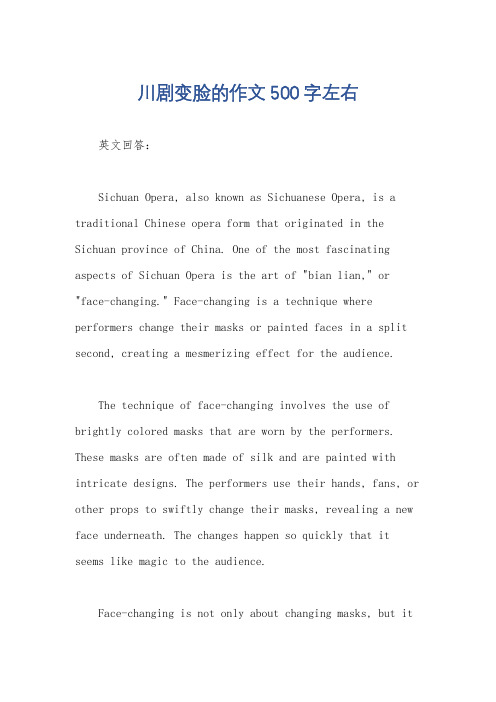
川剧变脸的作文500字左右英文回答:Sichuan Opera, also known as Sichuanese Opera, is a traditional Chinese opera form that originated in the Sichuan province of China. One of the most fascinating aspects of Sichuan Opera is the art of "bian lian," or "face-changing." Face-changing is a technique where performers change their masks or painted faces in a split second, creating a mesmerizing effect for the audience.The technique of face-changing involves the use of brightly colored masks that are worn by the performers. These masks are often made of silk and are painted with intricate designs. The performers use their hands, fans, or other props to swiftly change their masks, revealing a new face underneath. The changes happen so quickly that it seems like magic to the audience.Face-changing is not only about changing masks, but italso involves changing the entire demeanor and expression of the performer. Each mask represents a different character or emotion, and the performer must convey these changes through their body movements, gestures, and expressions. It requires a high level of skill and coordination to execute the face-changing technique seamlessly.One of the reasons why face-changing is so captivating is because it adds an element of mystery and surprise to the performance. The sudden transformation of theperformer's face leaves the audience in awe and wonder. It keeps them engaged and curious about what will happen next. The element of surprise also adds a sense of excitement and anticipation to the performance.Another reason why face-changing is so impressive is because it requires a great deal of practice and skill. Performers spend years mastering the technique and perfecting their timing and precision. They must be able to change their masks quickly and seamlessly without any visible signs of the transition. It is a skill thatrequires a deep understanding of the art form and a strong connection between the performer and the character they are portraying.Face-changing is not only a visual spectacle but also a reflection of the rich cultural heritage of Sichuan Opera. It showcases the creativity, artistry, and storytelling abilities of the performers. Each mask and change of face tells a story and conveys emotions and characters in a unique way. It is a form of expression that is deeply rooted in Chinese tradition and has been passed down from generation to generation.中文回答:川剧变脸是中国四川省的一种传统戏曲形式,又称川剧。
- 1、下载文档前请自行甄别文档内容的完整性,平台不提供额外的编辑、内容补充、找答案等附加服务。
- 2、"仅部分预览"的文档,不可在线预览部分如存在完整性等问题,可反馈申请退款(可完整预览的文档不适用该条件!)。
- 3、如文档侵犯您的权益,请联系客服反馈,我们会尽快为您处理(人工客服工作时间:9:00-18:30)。
脸谱被用来揭示剧中人物的内心思想感情的变化,即 把不可见、不可感的抽象的情绪和心理状态变成可见 、可感的具体形象。
Facial masks are used to reveal the inner thoughts and feelings of the play’s characters, that is, to turn the invisible, intangible, abstract emotion and psychological state into visible, sensible and specific image.
变脸的手法大体上分为三种:“抹脸”、“吹脸”、“扯脸 ”。此外,还有一种“运气”变脸。
The skills of face changing are generally differentiated into three types: the wiping mask, the blowing mask, and the pulling mask. Besides, there is another trick of using Qigong movements to change.
பைடு நூலகம்
因其技术性、神秘性和观赏性强,独显艺术之魅力! 斐声国内,享誉全球。
Because of its high technicality, mystique and ornamental value, it uniquely demonstrates the charm of art. It’s not only renowned domestically, but also commended globally.
川剧变脸早已成为国家二级机密,现被列为国家级 非物质文化遗产。
The face changing in Sichuan opera has already become the national secondary confidential, and now it’s listed as the state-level intangible cultural heritage.
Translation
变脸是川剧表演的绝活之一,是运用在川剧艺术中塑 造人物的一种浪漫主义手法。脸谱被用来揭示剧中人 物的内心思想感情的变化,即把不可见、不可感的抽 象的情绪和心理状态变成可见、可感的具体形象。变 脸的手法大体上分为三种:“抹脸”、“吹脸”、“扯脸”。 此外,还有一种“运气”变脸。川剧变脸早已成为国家 二级机密,现被列为国家级非物质文化遗产。因其技 术性、神秘性和观赏性强,独显艺术之魅力!斐声国 内,享誉全球。
变脸是川剧表演的绝活之一,是运用在川剧艺术中塑 造人物的一种浪漫主义手法。
Face changing is one of the unique skills in Sichuan opera performance,which is of the romantic style to be used in the opera art to characterize.
